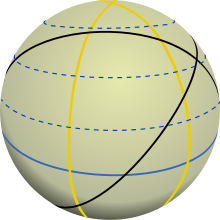Great circle
A great circle is the largest possible circle on a spherical surface . Its center always coincides with the center of the sphere and a cut on the great circle divides the sphere into two ("equal") halves. Since there are infinitely many possibilities to cut a sphere in such a way that the cutting plane meets the center of the sphere, there are also an infinite number of great circles.
Great circles play z. B. in geography as well as shipping and aviation an important role. They are also used to determine the time zones. The spherical geometry contains great circles as an elementary component. Understanding the orthodromes as the shortest connection between two points on a spherical surface is essential for understanding the “straight line”, unaccelerated (departure from the concept of gravitation ) movement in curved space ( general theory of relativity , space curvature ).
In the geographic coordinate system of the earth, there are special cases of great circles. They are specially positioned great circles. These special cases are the equator (here solid blue line) and the longitudes (here yellow line). The equator is the great circle that separates the globe in the middle between the south and north poles. The longitudes go through the south and north poles. On them lie the meridians , which each extend from the north to the south pole , such as B. the prime meridian (0 °) and the 180 ° meridian. The meridians are also called longitudes. On the other hand, the parallels (here dashed lines), with the exception of the equator, are not great circles, but smaller than the maximum circumference of the sphere. They are therefore called minor or minor circles .
On great circles of the earth , one arc minute corresponds to one nautical mile , abbreviated to sm ( nautical mile , nm or NM ). It can be calculated (ie as a "minute of length" or as a "minute of latitude at the equator") at 1852 meters with an assumed circumference of 40,000 km. The mean earth radius is 6371 km.
The shortest connection between two points on a spherical surface - the so-called orthodrome - is always part of a great circle (the so-called main arc). That is why shipping and, above all, air routes mostly lead along great circles. Driving around the globe on orthodromes is called great circular sailing; at the start and finish point at a similar geographical latitude, the "great circle courses" run over somewhat larger latitudes (e.g. Munich - Beijing via Siberia ).
On the earth's ellipsoid and other surfaces, the orthodrome is called the geodetic line . It is a curve of a higher order (deviation from the great circle of a sphere by a few per thousand) and corresponds to the course of a taut, frictionless thread . On the earth ellipsoid, e.g. B. according to WGS84 , one calculates the initial course and distance according to the formula of Thaddeus Vincenty .
Representation on maps
Since many maps (e.g. the Mercator map ) are displayed in such a way that the latitudes appear as straight, horizontal lines, the flight routes appear curved despite their shortness and continue towards the poles (see also Loxodrome ). To make drawing easier, there are special great circle maps (see gnomonic projection ), on which all great circles appear as straight lines, but the surroundings are somewhat distorted. Shortest flight routes and long shortest ship routes (e.g. when crossing the Atlantic ) can be displayed as straight lines on a gnomonic map. The compass course to be driven changes constantly and can be read on the map as the angle between the meridian and the course line.
On nautical charts , the latitude is shown on the right and left edges , i.e. H. the respective section of the relevant great long circle. Here the navigator can use the compass to grasp a distance (1 arc minute = 1 nautical mile = 1.852 km) and transfer it to the map to draw positions and courses.
calculation
The angle between points A and B with the latitude coordinates and the longitude coordinates on the great circle is calculated as follows:
If specified in radians, the great circle distance d between the two points can be calculated from the earth's radius r E :
The great circle distance is a maximum of half the circumference of the earth.
The angle of intersection of the great circle of A and B with the meridian at point A is called the course angle . It is calculated with:
For eastern courses (λ B > λ A ) the course angle is between 0 ° and 180 °, for western courses (λ B <λ A ) the course angle is between 180 ° and 360 °. In contrast to the flat geometry, the course angles from A to B and from B to A do not differ by 180 °. In the extreme case, when the great circle leads over the poles, the two course angles can even be the same.
Web links
- Formula collection for great circle navigation
- Great Circle Mapper - Great Circle mapper including ETOPS ranges
- Great circle calculator









